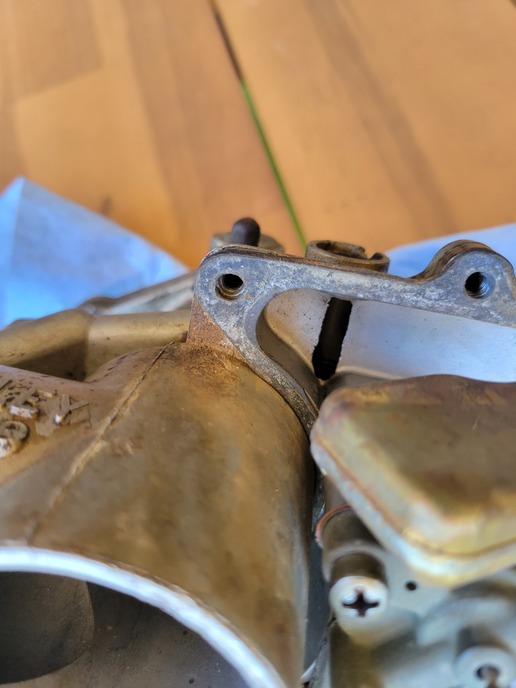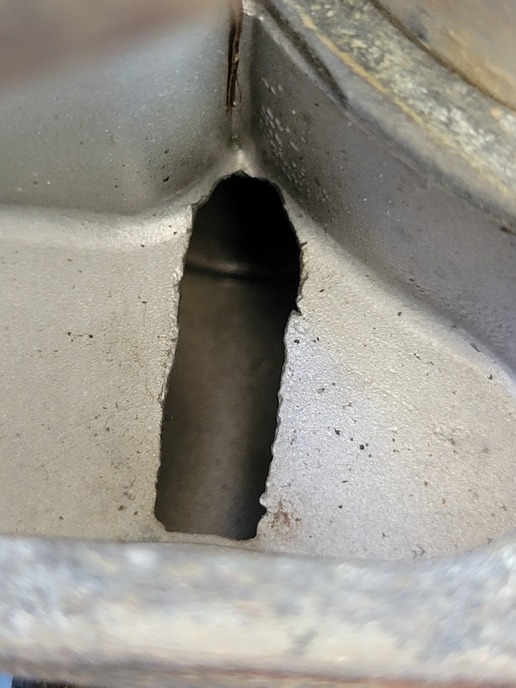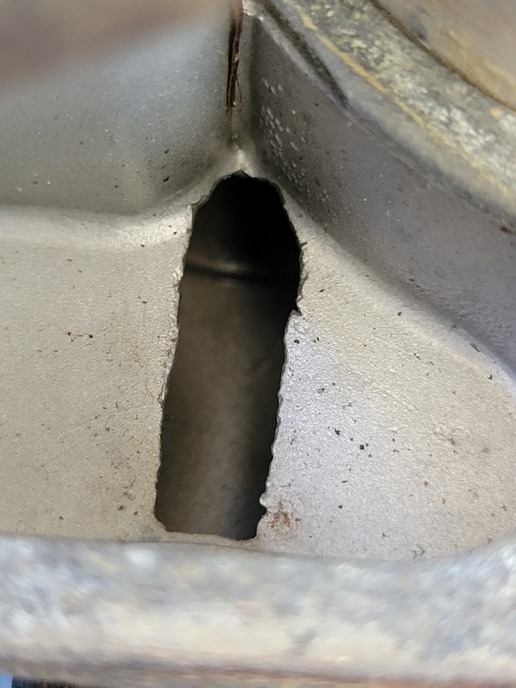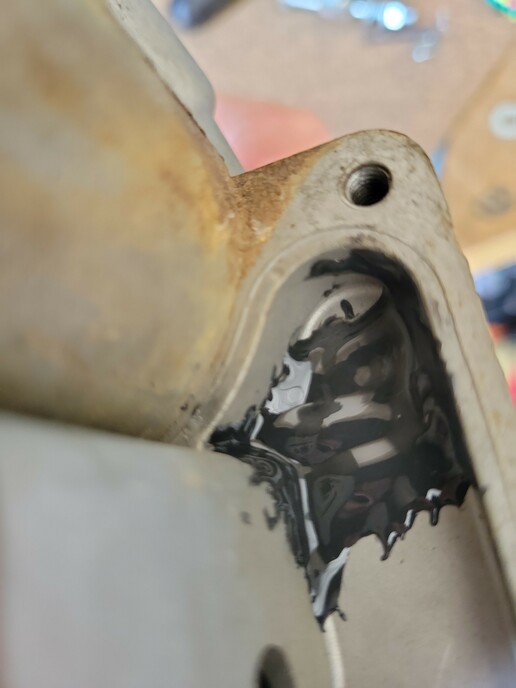YSoCyrious
New User
Hi everyone! I'm new here... I have novice experience with engines -
Current Problem: Tractor won't start, carburetor floods.
History: Tractor has been running fine (minor hiccups here and there - I assume that's normal). However, I had it out bush-hogging recently (probably about 2
weeks ago now), and all of a sudden it sounded like engine pressure dropped and then it slowly hummed to a stop; I haven't been able to start it since. I pulled
the carburetor and discovered a chunk of the carburetor had blown apart, ceiling of carb below what appears to be a channel for fuel and/or air (while choked).
Please see photo for location, and size. I have since repaired the break with JB Weld, as well as tried a new carburetor. Now, all I have is an engine that
won't turn over, and the carb floods after (maybe) 20 seconds or so of trying to turn it over.
KNOWN ISSUES:
1) 1x Broken carburetor
2) Fuel Leak at the mechanical fuel pump - Seemed as though the gasket finally gave way. Repaired with new gasket - no leaks detected.
3) Fuel Leak at Fuelock - Not fixed (yet), new fuelock on its way here
4) Fuel leaks out of carburetor after attempting to turn over for 20secs or longer - No idea here
5) OLD (probably useless) Air cleaner Filters - It would appear the last time these were changed was August of 1998 - new filters ordered, have not yet arrived.
6) Discovered that 1 of my flare-nuts on the Timing Advance vacuum line was stripped (the end at the distributor side). However, this appears to be an old
problem, as the stripped bore appears to be weathered and therefore an old problem. Also... I have never touched the vacuum line even while servicing the below.
7) Due to #5 above, I assumed that the tractor hadn't been adequately serviced in quite some time... So I did the following:
Applied fixes:
Prior to Carburetor blowing out -
1) Surfaced cleaned carburetor with Carb cleaner, inside of carb appeared fairly clean - Pitting noticed and a white-ish film was present - assumption is
ethanol gasoline was used. I have been using ethanol-free gasoline since my purchase.
2) Oil Change/Cleaned Air filters/Oil Filter change - Oil was a black as could be. Previous owner, despite being a mechanic, instructed me to simply add oil
before each use. Yes, I know it's not a fuel additive, it's a lubricant. I did allow plenty of time for both air filters to air dry in the sun prior to install
and use. Tractor was running great after this.
3) Spark Plug Change - again due to #5 above, I didn't want to take any chances. I also noticed that the Spark Plug Gap was wider (.030 or higher) than specs in
manual (.023-.027). I gapped the plugs to manual specs. [Question 1 - Should I put gap back to .030, as the tractor had no problem running during this time
period?]
3) Coolant Flush and refill with new coolant - Again, due to #5 above, I had no idea the condition of these systems. I did have a couple of moments where the
engine seemed to overheat, turned off, and wouldn't start again until cooled. I was worried the water pump might have gone... however, with running starter, I
was able to purge coolant out of lower Coolant line after the system was completely drained - assumption is that what was left was in pump, and as it turned
with starter crank, it emptied.
After Blow out:
1) Purchased a Zenith-like carb (Zenith is something like $530) I know Chinese knock-offs aren't quite the quality of what they are modeled after, but it did
appear VERY similar. After finding new mounting nuts, and other parts it didn't come with, and the originals wouldn't fit - I mounted and reattached everything.
Tractor wouldn't turn over, and carburetor started leaking after 20-30 seconds of cranking - not even a hint of starting was detected.
2) Applied JB Weld to Holley Carburetor - I attempted to keep the amount minimal, as I didn't want to diminish the bowl capacity or function. I applied an even
coat allowed more than 24 hours of curing to ensure a tight bond. After reinstalling, I still had the same issue where the tractor wouldn't turn over, and
simply flooded the carburetor.
3) Disassembled Holley Carb- cleaned all innards, and lubricated with a light coat of lubricant (wiped excess). Ensured Needle seat, and needle were cleaned and
free of debris. Reinstalled, still having same flooding issues, with no turn over.
4) I have ordered a 3rd carburetor - Zenith, from Farmer Bob... However, I am not sure that it is the Carburetor anymore... as having installed another produces
the same symptoms - no start, flooded carburetor.
Here are my assumptions:
It seems that either the engine still isn't getting any gasoline into intake manifold/cylinder, or I have a new/worsened electrical spark issue that needs
attention.
QUESTIONS:
1) Should I re-gap the spark plugs to the specs measured on old spark plugs I pulled?
2) Why isn't the engine attempting to fire?
3) Possible Fixes? I have pulled the carb again, and I am going to try and do a much deeper clean on it, I will try to focus on all orifices, and attempted to
see if any of the jets are clogged - I have seen some folks try to clear them with a strand of wire - what is the best technique?
4) Obviously I am working on the fuel leaks, I am simply awaiting the parts. I will say that the fuel leaks seemed to have worsened since the Holley Carb
blowing up. Either way, I have parts ordered, and I am simply waiting for their arrival to install. Hopefully these shouldn't be/aren't the problem.
5) Is it fair to assume the fuel pump is working since turning the ignition causes spurts of fuel seen in the glass fuel filter, and that the carb is flooding.
I was working under the assumption that it IS working appropriately, as if it weren't there wouldn't be fuel flooding the carb.
6) Is it possible that the particles of the carb that broke free could have messed up my new plugs, and be the cause for the engine not firing? I don't know the
chemical properties of the materials used in plugs/carb to accurately guess that this could be an issue.
7) Is it possible that there are chunks of my carb somewhere in either the intake manifold or combustion chamber that could be causing them to not fire? As I
said, I have no idea if the particles of the carb have cleared or not.





Current Problem: Tractor won't start, carburetor floods.
History: Tractor has been running fine (minor hiccups here and there - I assume that's normal). However, I had it out bush-hogging recently (probably about 2
weeks ago now), and all of a sudden it sounded like engine pressure dropped and then it slowly hummed to a stop; I haven't been able to start it since. I pulled
the carburetor and discovered a chunk of the carburetor had blown apart, ceiling of carb below what appears to be a channel for fuel and/or air (while choked).
Please see photo for location, and size. I have since repaired the break with JB Weld, as well as tried a new carburetor. Now, all I have is an engine that
won't turn over, and the carb floods after (maybe) 20 seconds or so of trying to turn it over.
KNOWN ISSUES:
1) 1x Broken carburetor
2) Fuel Leak at the mechanical fuel pump - Seemed as though the gasket finally gave way. Repaired with new gasket - no leaks detected.
3) Fuel Leak at Fuelock - Not fixed (yet), new fuelock on its way here
4) Fuel leaks out of carburetor after attempting to turn over for 20secs or longer - No idea here
5) OLD (probably useless) Air cleaner Filters - It would appear the last time these were changed was August of 1998 - new filters ordered, have not yet arrived.
6) Discovered that 1 of my flare-nuts on the Timing Advance vacuum line was stripped (the end at the distributor side). However, this appears to be an old
problem, as the stripped bore appears to be weathered and therefore an old problem. Also... I have never touched the vacuum line even while servicing the below.
7) Due to #5 above, I assumed that the tractor hadn't been adequately serviced in quite some time... So I did the following:
Applied fixes:
Prior to Carburetor blowing out -
1) Surfaced cleaned carburetor with Carb cleaner, inside of carb appeared fairly clean - Pitting noticed and a white-ish film was present - assumption is
ethanol gasoline was used. I have been using ethanol-free gasoline since my purchase.
2) Oil Change/Cleaned Air filters/Oil Filter change - Oil was a black as could be. Previous owner, despite being a mechanic, instructed me to simply add oil
before each use. Yes, I know it's not a fuel additive, it's a lubricant. I did allow plenty of time for both air filters to air dry in the sun prior to install
and use. Tractor was running great after this.
3) Spark Plug Change - again due to #5 above, I didn't want to take any chances. I also noticed that the Spark Plug Gap was wider (.030 or higher) than specs in
manual (.023-.027). I gapped the plugs to manual specs. [Question 1 - Should I put gap back to .030, as the tractor had no problem running during this time
period?]
3) Coolant Flush and refill with new coolant - Again, due to #5 above, I had no idea the condition of these systems. I did have a couple of moments where the
engine seemed to overheat, turned off, and wouldn't start again until cooled. I was worried the water pump might have gone... however, with running starter, I
was able to purge coolant out of lower Coolant line after the system was completely drained - assumption is that what was left was in pump, and as it turned
with starter crank, it emptied.
After Blow out:
1) Purchased a Zenith-like carb (Zenith is something like $530) I know Chinese knock-offs aren't quite the quality of what they are modeled after, but it did
appear VERY similar. After finding new mounting nuts, and other parts it didn't come with, and the originals wouldn't fit - I mounted and reattached everything.
Tractor wouldn't turn over, and carburetor started leaking after 20-30 seconds of cranking - not even a hint of starting was detected.
2) Applied JB Weld to Holley Carburetor - I attempted to keep the amount minimal, as I didn't want to diminish the bowl capacity or function. I applied an even
coat allowed more than 24 hours of curing to ensure a tight bond. After reinstalling, I still had the same issue where the tractor wouldn't turn over, and
simply flooded the carburetor.
3) Disassembled Holley Carb- cleaned all innards, and lubricated with a light coat of lubricant (wiped excess). Ensured Needle seat, and needle were cleaned and
free of debris. Reinstalled, still having same flooding issues, with no turn over.
4) I have ordered a 3rd carburetor - Zenith, from Farmer Bob... However, I am not sure that it is the Carburetor anymore... as having installed another produces
the same symptoms - no start, flooded carburetor.
Here are my assumptions:
It seems that either the engine still isn't getting any gasoline into intake manifold/cylinder, or I have a new/worsened electrical spark issue that needs
attention.
QUESTIONS:
1) Should I re-gap the spark plugs to the specs measured on old spark plugs I pulled?
2) Why isn't the engine attempting to fire?
3) Possible Fixes? I have pulled the carb again, and I am going to try and do a much deeper clean on it, I will try to focus on all orifices, and attempted to
see if any of the jets are clogged - I have seen some folks try to clear them with a strand of wire - what is the best technique?
4) Obviously I am working on the fuel leaks, I am simply awaiting the parts. I will say that the fuel leaks seemed to have worsened since the Holley Carb
blowing up. Either way, I have parts ordered, and I am simply waiting for their arrival to install. Hopefully these shouldn't be/aren't the problem.
5) Is it fair to assume the fuel pump is working since turning the ignition causes spurts of fuel seen in the glass fuel filter, and that the carb is flooding.
I was working under the assumption that it IS working appropriately, as if it weren't there wouldn't be fuel flooding the carb.
6) Is it possible that the particles of the carb that broke free could have messed up my new plugs, and be the cause for the engine not firing? I don't know the
chemical properties of the materials used in plugs/carb to accurately guess that this could be an issue.
7) Is it possible that there are chunks of my carb somewhere in either the intake manifold or combustion chamber that could be causing them to not fire? As I
said, I have no idea if the particles of the carb have cleared or not.






